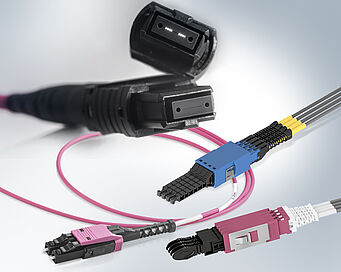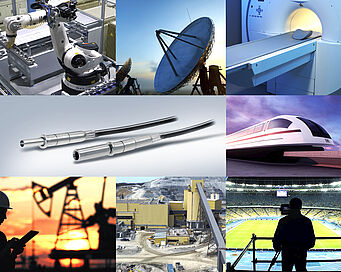An overview of important technical terms and the basics of fibre optic cabling. In our glossary we explain certain terms which you can find in our product descriptions. The blog posts about fiber optic technology serve as assistance and to deepen individual contents.
Fiber optic technology & lexicon
Fiber Optic Technology - Basics of Optical Fiber Cabling
07/04/2024
Comparison of the PreCONNECT® OCTO cabling systems
Comparison of the PreCONNECT® OCTO cabling systems - MTP®, LC, SN® Quad & MDC Quad
Ethernet-, FibreChannel and InfiniBand™ standards
Singlemode or multimode?
05/06/2024
Robust connector interface for fiber optic cables
EBO technology offers a solution for the use of fiber optics in demanding environments - with high-quality connectors such as the Size 12 lens connector.
04/25/2023
Update 400/800G optical transceiver
Who will win the race as the fiber optic connector interface?
How is the topic of port breakout developing?
What contribution can transceivers make to sustainability in the data center?
A
Absorption
Loss of radiation as the beam passes through a medium (a part of the radiant energy in the light is converted into heat, for example).
APC (Angled Polished Contact)
Grinding the fiber endface at an angle - usually 8°- means that reflected light is no longer propagated. Reflections are reduced to a minimum.
Attenuation A
Measure of the loss of power of a signal in a transmission path - see Insertion Loss.
B
Bandwith
Width of an interval in the frequency spectrum that can be used in a transmission cable.
C
Cable core
Totality of the elements located at the inside of the cable, including stranded, support, strain relief and joining elements and all the layers wound around these elements.
Cable jacket
Plastic cladding that protects the cable core against environmental influences.
CATV (Cable Television or Community Access Television)
Television provided to multiple users via radio frequency (RF) signals transmitted through coaxial or fiber-optic cables.
Center Element
Element running centrally in a cable. In the case of fiber optic cables, usually used as a strength member.
Cladding
Glass cladding that surrounds the core of an optical fiber. The refractive index is a little lower than that of the core.
Core Glass
Core of an optical fiber with a refractive index that is higher than that of the cladding glass.
Coupler
Element used to split or merge optical signals. Couplers are often used as passive fiber optic elements in data transfer. Alongside couplers with different division ratios, wavelength-dependent or polarization-dependent types are also used.
Coating
Plastic layer that is applied directly to the optical fiber. It provides protection against mechanical and chemical influences (air).
Connector
Element for the releasable connection of optical fibers and/ or electrical conductors.
Core
Fiber acting as a light guide. The fiber specification indicates the diameter of the core / cladding (e.g. 50 / 125 μm).
Crimping
Method in which a sleeve is pressed around the fiber/core in order to create a mechanical join (for strain relief ).
D
Decibel
Logarithmic measure for a transmission ratio. Losses (attenuation) or gains in signals are usually expressed indecibels [dB]. A[dB]=10*log (Pout/Pin)
DIN
German standardization institute; DIN EN identifies the European version of the standard.
Dispersion
Dispersion occurs when signal components are transmitted in a medium with different transmission times. The signal quality is reduced. In optical fibers, the most important types of dispersion are modal dispersion in multimode fibers and chromatic dispersion in singlemode fibers.
Doping
Intentional introduction of very small quantities of an extraneous material in a pure substance in order to modify its characteristics, e.g. to increase the refractive index of the fiber core.
E
Electromagnetic Waves
Periodic changes of state of the electromagnetic field that propagate as waves traveling at the speed of light. At optical frequencies, these are referred to as light waves.
EMC (electromagnetic compatibility)
Resistance to electromagnetic interference and interference emitted by a cable or system.
F
Ferrule
Connector pin (usually ceramic) responsible for ensuring the precise axial guidance of the fiber in the connector.
Fiber (also fibre)
Transmission medium consisting of a core and cladding.
Fiber Optics
In this transmission technology, electromagnetic waves (information) are guided along optical fibers in the form of light.
FITL (fiber in the loop)
Fiber in a local access network.
A distinction is made between the following depending on the endpoint of the fiber:
FTTB - fiber to the building: fiber as far as the building
FTTC - fiber to the curb: fiber as far as the edge of the street
FTTH - fiber to the home: fiber as far as the user’s home, and
FTTP - fiber to the premises: fiber as far as the upstream device
FTTD (fiber to the desk)
Structured cabling of a building (LAN) with optical fibers all the way to the workplace.
G
GBE
Gigabit Ethernet; name of a network transmission protocol.
Graded Index Fiber
Type of optical fiber in which the refractive index of the core has a parabolic profile and decreases from the inside to the outside This type of fiber permits improved dispersion and transmission characteristics.
Graded Index Profile
Refractive index of an optical fiber. The refractive index of the core decreases from the center toward the cladding, usually as a parabolic function.
GRP Element
Supporting element designed to absorb tensile forces. Made from fiber-optic reinforced plastic (GRP).
H
HCS Fiber (Hard-Polymer Cladded Silica Fiber)
Fibers with a core made of quartz glass together with a plastic cladding.
HRL (High Return Loss)
See APC
HU
Height unit of the 19-inch system. 1 HU corresponds to 44.45 mm or 1.75 inches.
I
IEC
International Electrotechnical Commission
IEEE
Institute of Electrical and Electronic Engineers. International organization of electrical and electronic experts that publishes its own standards. Member of ANSI and ISO. The IEEE 802 project is concerned, in particular, with LAN standards.
Indoor Cable
Cable with a structure specially designed for use inside buildings.
Iinfiniband
A parallel optical transmission technology based on the use of 4 channels.
Insertion Loss
Ratio of the introduced light power to the emitted power of an optical component. Attenuation [dB] resulting from the insertion of an optical component in an optical transmission path.
Interferometer
Measurement system used to analyze and measure connector endfaces.
ISDN (lntegrated Services Digital Network)
Data, voice and images are sent in digital form over the existing telephone network.
J
No entry.
Back to the top
K
No entry.
Back to the top
L
LAN (local area network)
A local network for the bitwise serial transmission of information between separate terminal devices.
Light
Traditionally, the term "light" has been understood to refer to electromagnetic wavelengths between 380 nm (violet) and 780 nm (red). A less restrictive definition also includes the neighboring areas of the spectrum, optical wave guide.
Loose Buffer Fiber
Multiple loose fibers located, without being subject to stress, in a shared tube which may or may not be filled.
Loose Tube
An optical fiber surrounded by loose tubing.
M
MAN (metropolitan area network)
Transregional network for information transfer.
Microbending
Tiny geometrical irregularities at the boundary between the core and cladding. Microbending results in the excitation of higher-order modes that are subject to higher levels of attenuation.
Modal Bandwith
Constant describing the product of the bandwidth and length of the optical fiber.
Modes
All the light waves of the same wavelength capable of propagation in an optical fiber.
MTP® Connector
A connector with n x 12 fibers in a ferrule. MTP® is a registered trademark of US-Conec Ltd.
Multimode Fiber
Type of fiber in whose core multiple waves (modes) are able to propagate. The number of modes depends on the size of the fiber core. Typical dimensions are 50 / 125 μm and 62.5 / 125 μm.
Multiplex
Method used in order to transport multiple signals simultaneouslyover one and the same transmission path. Each of these signals is assigned a timeslot, a wavelength or a fiber, for example.
N
No entry.
Back to the top
O
Optical Fiber (also fibre)
The electrical, transparent fibers used to transmit signals using electromagnetic waves at optical frequencies.
Optical Fiber Waveguide
See optical fiber
Optical Window
Optical fibers have particularly low attenuation values at the wavelengths 850 nm, 1300 nm, 1550 nm and 1625 nm.
OTDR (optical time domain reflectometer)
Measuring equipment used to characterize a fiber optic transmission path on the basis of the backscattering pattern from a light pulse. OTDR can therefore be used to determine the attenuation gradient along a fiber path as well as its reflective characteristics.
Outdoor Cable
Cable suitable for installation in the ground or in cable ducts.
P
Parallel Optic Link
In multimode operation using the InfiniBand and 40/100 GBE protocols.
Patchcord
Connecting cable for connections in a distribution panel.
PC
Physical Contact; the ferrule endface is polished in such a way that the fiber endfaces of the connector are in contact.
Pigtail
A fiber optic section with a connector at only one end.
PON (Passive Optical Network)
Passive optical network for FITL with passive components such as couplers, splitters and connectors.
Q
No entry.
Back to the top
R
Reflection
Waves returned against the incident direction in a fiber link.
Refraction
Change in the direction of propagation of a beam (a wave)at the boundary surface between two media with different refractive indexes.
Refractive Index
Factor by which the speed of light in an optical medium (e.g. glass) is smaller than in a vacuum.
Return Loss
Loss of input optical power due to reflections in an optical link.
Ribbon Cable
Cable with fibers running in a parallel plane.
S
SAN
Storage Area Network
Semi Tight Tube Fiber
Fiber in a small plastic tube (gap either dry or filled with gel).
Single Mode Fiber
Fiber in whose core only one light wave (mode) is capable of propagation. Usual value: 9 / 125 μm.
Spine-Leaf-Architecture
The spine-leaf architecture, which is already in widespread use, uses the idea of the non-blocking network. In such networks, every leaf switch is connected to every spine switch.
Splice Connection
Permanent connection between two optical fibers created by fusing the fibers or by means of an adhesive.
Splitter
This optical component can be used to divide the optical power from a single fiber among multiple fibers.
Also see Coupler
Step Index Fiber
Fiber type whose core has a uniform refractive index.
Step Index Profile
See step index fiber
Strength Member
Mechanical element (usually in the form of kevlar fibers) present in the cable in order to absorb tensile and compressive forces.
T
Tight Tube
An optical fiber core in which a fixed plastic sheath is applied directly above the protective cladding (intermediate silicon layer).
Time Division Multiplex
Transmission method in which multiple parallel incoming digital signals are transmitted on a single cable as a serial data stream.
U
No entry.
Back to the top
V
No entry.
Back to the top
W
WAN (wide area network)
Long-distance network for information transfer.
Wavelength
Length of one full oscillation (period) of a wave. In optical communications technology, wavelengths that match the optical window are used.
Wavelength Division Multiplex
See WDM.
WDM / DWDM (Dense Wavelength Division Multiplexing)
Light beams of different wavelengths rather than of just a single wavelength are sent through the optical fiber.
X
No entry.
Back to the top
Y
No entry.
Back to the top
Z
No entry.
Back to the top



